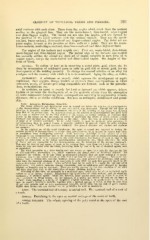Page 433 - My FlipBook
P. 433
GLOSSARY OF TECHNICAL TERMS AND PHRASES. 281
axial surfaces with each other. These form line angles which reach from the occlusal
surface to the gingival line. They are the mesio-buccal, disto-buccal, mesio-lingual
and disto-lingual angles. The second set are also line angles, and are formed by
the junction of the axial surfaces with the occlusal surface. They are the mesio-
oeelusal, bucco-occlusal, disto-occlusal and linguo-occlusal angles. The third set are
point angles, formed by the junction of three walls at a point. They are the mesio-
bucco-occlusal, mesio-linguo-occlusal, disto-bucco-occlusal and disto-linguo-occlusal.
The angles of the incisors and cuspids are : First set, mesio-labial, disto-labial,
mesio-lingual and disto-lingual angles. The incisal edge of the incisors and cuspids
has normally neither the second nor third set of angles complete in such form as to
require names, except the mesio-incisal and disto-incisal angles. See Angles of Sur-
faces of Teeth.
Anneal. To soften by heat as in annealing a metal plate, gold, silver, etc. To
clean by evaporation of condensed gases or salts on gold foil or crystal gold, for the
development of the welding property. To change the mutual relation of an alloy for
amalgam and the mercury with which it is to be combined. Aging the alloy, so called.
Antiseptic. A substance or remedy which opposes the development of septic
conditions; that opposes, delays, hinders or prevents those decompositions in which
poisonous, septic, or disease-producing compounds are formed; such as the putrefac-
tions, fermentations, etc.
In medicine, an agent or remedy for local or internal use which opposes, delays,
hinders or prevents the development of, or the systemic effects from the absorption
of, toxic compounds formed by those decompositions occurring in suppurating wounds,
abscesses, ulcers, or similar conditions. See note on antiseptic, disinfectant and germi-
cide.
Note : Antiseptic, Disinfectant, Germicide.
of microorganisms
The words antiseptic and disinfectant were in general use before the relation
to the decompositions and to disease, as now understood, was discovered. Though the old form of
definition is generally retained in dictionaries, the idea of the meaning of the terms was different
from that of the present time. An antiseptic restrains the activity of microorganisms and gives local
parts time to recover and, by the vital powers of the tissues, to further restrain, or overcome their
growth in the tissues on the one hand, or serves to ameliorate the effects of septic poisons already
produced and absorbed into the circulation on the other. After this idea an antiseptic is a remedy
of_ local or of systemic usefulness. To be useful locally, it must be decisively more poisonous to
microorganisms than to animal tissues, a property exhibited in greatest degree by mild solutions
of carbolic acid, " 1-2-3," and mercuric bichlorid. For general systemic use, alcohol and cinchona
are examples.
In the original use of the word disinfectant, the agent so named was supposed to destroy the
noxious products of decomposition, to render them non-poisonous', or to destroy or remove foul odors
or emanations from decomposing material. "With increasing knowledge of the relation of micro-
organisms to the decompositions and to the formation of foul odors and of disease-producing poisons,
or toxins, so called, the idea expressed by the word disinfectant has become changed to that of the
removal or destruction of the actual microorganisms, plasmocites, etc., which constitute the virus
of disease and are responsible for the decompositions and the formation of the noxious compounds.
This may be done by any means at hand, as by washing them away from the hands or from instru-
ments by soap and water with the brush, destroying them by heat or by use of chemical agents, such
as germicides.
The word germicide is a later development and means an agent that actually destroys the life
of microorganisms, plasmocites, etc., which constitute the actual virus of infectious diseases. All
germicides are poisons. It is only when in attenuated solutions they are more poisonous to micro-
organisms than to the animal tissues or cells that they may be used as antiseptics. Inanimate sub-
stances, such as instruments, clothing, bedding, rooms, etc., may properly be disinfected with germi-
cides when the chemical relations of the substances to each other are such that material injury to the
articles disinfected will not occur. When sufficient heat can be used, it is usually the best and safest
disinfectant. For certain purposes, gaseous germicides, such as sulphurous acid obtained by burning
sulphur, or formalin may be employed. These are readily removed by the free admission of air after
they have done their work in the disinfection of rooms, clothing, bedding, etc.
According to this view, an antiseptic is a medicinal agent which may be of use in topical appli-
cations or as an internal remedy. Disinfectants and germicides are extra medical, and are chemical,
mechanical, or physical agents. There are, however, some special conditions in which it is wise to
use a germicide on living tissues. As, for instance, if a person has broken the skin on the hand or
a finger while handling a cadaver, or dangerous surgical material, it is much better to destroy at
once the possible infectious material, together with a limited amount of tissue, as may be done with
95 per cent carbolic acid or with concentrated formalin, rather than run the risk of grave disease.
Within such limits only can disinfectants or germicides be used as medicines.
Apex. The terminal end of a cone; a conical end. The terminal end of a root of
a tooth.
Apical. Pertaining to the apex or conical endings of the roots of teeth.
Apical foramen. The minute opening of the pulp canal at the apex of the root
of a tooth.


